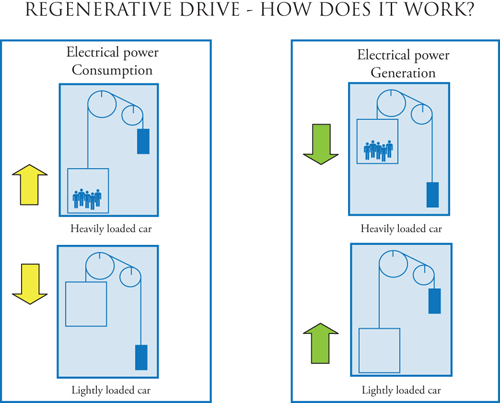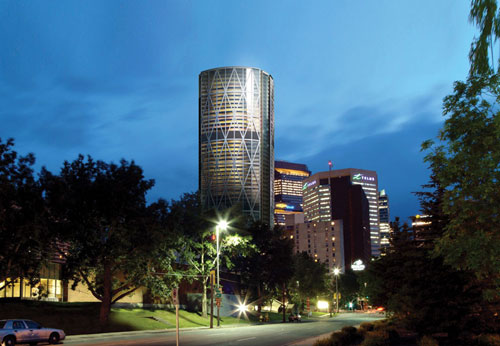This CE Center article is no longer eligible for receiving credits.
Vertical transportation, which has been part of the building environment since the 1850s, has recently seen some significant advancements. One of the most recent, introduced in the 1990s, is machine-roomless (MRL) technology, named for its ability to dispense with the traditional elevator machine room. Based on the first major breakthrough in lifting technology in nearly 100 years, MRL technology continues to evolve, offering even greater design freedom for architects, revenue-producing building space, and savings in construction and operational costs.
As owners increasingly demand energy savings, lower carbon footprints, and U.S. Green Building Council LEED certifications, architects should understand how MRLs can contribute to those goals as well. This article will explain the latest advances in MRLs, their advantages over conventional elevators, and highlight the features that make for the greenest MRLs. Escalators will also be discussed in terms of what elements architects should look for in specifying the most energy efficient systems.
The Latest Advances in Machine-Roomless Elevators
Historically, traction and hydraulic elevators required sizeable machine rooms to store large machines, motors, or hydraulic pumps. In the 1990s, advances in technology enabled gearless machine-roomless elevators, which employ a smaller sheave and a redesigned machine that could be mounted within the hoistway itself, eliminating the need for a bulky machine room on the roof. A smaller controller room could be positioned with some flexibility near the hoistway. However, hydraulic elevators still required a full-size machine room.
 |
Considered groundbreaking when it was first introduced, gearless MRL technology has virtually replaced the traditional geared machine type traction elevator that has dominated the mid-rise market for more than half a century, and has made inroads into the hydraulic market. Advances continue, with major manufacturers offering their own MRL solutions and innovations. In 2011, gearless models were introduced that eliminate the need for any sort of separate elevator control space, enabling all elevator support equipment to be placed within the hoistway and creating a true machine-roomless model. Also in 2011, true MRL technology was extended into hydraulic elevators, enabling those models to dispense with their full-size machine rooms. In short, with the latest advances, the elevator has become a self-contained system.
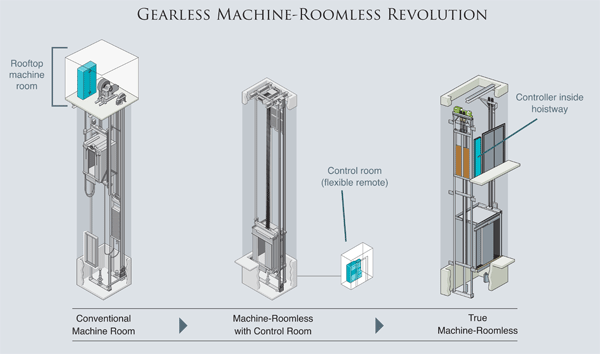
Chart courtesy of Otis Elevator Company
The advantages of this are several fold. Architects are free to use the extra space, which can be as large as 100 square feet per elevator, to support their design vision. Higher use of that extra space, such as additional apartments or offices, enables developers and owners to manage the building more economically as well as benefit from lower building costs. Because an elevator machine room is not just four walls, but a space that requires a complex system of lights, fire protection, and HVAC equipment, eliminating the room altogether results in reduced construction costs and time, materials, and coordination issues on the jobsite. With fewer moving parts, installation can be simpler than for conventional elevator systems, with decreased requirements for interfaces and roof penetrations. In some instances, elevators can be installed via the hoistway, without having to be positioned by expensive overhead cranes. On certain products, hall call buttons can be integrated into the elevator doorjambs, rather than on building walls, which further reduces time and interface among trades on the jobsite. Newer models can have lead times as short as six weeks — half the industry average — due to their modular design, automation, and proximity of the factory. Shorter lead times enable the architect to “push the order button” on an elevator already specified when the project is further along and the owner has selected the elevator's final aesthetics. At this point, the installation date can be more realistically targeted. This avoids having to pay costly storage fees for elevators that arrive on site when the construction project is facing delays. Some true gearless MRLs are also good options from an environmental perspective. Their smaller footprints, more efficient motors and regenerative drives can reduce HVAC demand and require up to 75 percent less energy than their traditional counterparts.

Image courtesy of Otis Elevator Company
A. Conventional System: Requires dedicated machine room space

Image courtesy of Otis Elevator Company
B. MRL Holeless Hydraulic System: More usable space in your building
True MRL for the Holeless Hydraulic System
Machine-roomless systems have been available with traction systems for years, but they were not available as a major construction hydraulic product offering until very recently. The critical components of the true MRL holeless hydraulic system — oil tank, controller, and main disconnects — have been redesigned to fit into a standard hoistway, that is, a hoistway with the same depth and width, pit depth, and overhead allowance as a conventional holeless hydraulic elevator. Access to these components is obtained through a standard door that can be located on a hoistway wall on the first or second elevator landing.
The hydraulic elevator system, in which the elevator car is pushed from below by a plunger, is the oldest operating system and the least expensive. Though highly dependable, hydraulic elevators run at lower speeds, and are thus designed for low- and medium-rise applications. Holeless systems are environmentally preferable to holed options, where the cylinder is buried underground in a hole equal in depth to the rise the elevator travels. A PVC liner protects the walls of the cylinder from underground contaminants. For the holeless option, there is no inground cylinder. Its side-mounted plungers are surface mounted at the base of the hoistway, which eliminates the need for drilling a hole into the ground to accommodate the plunger — a scenario that precludes any possibility of oil seepage into the ground, thereby lowering the risk of soil and groundwater contamination.
Manufacturers estimate that the true MRL holeless hydraulic system saves up to $10,000 in time and material costs on the construction site, while enabling more revenue-generating space for the owner. Savings is due to elimination of the need to build a large hydraulic machine room with walls, lights, fire protection and HVAC system.
True MRL For the Traction Elevator
The true machine-roomless option, meaning that all components fit in the hoistway, has also come to traction elevators, which dominate the medium- and high-rise market. A traction elevator system works like a pulley — on one end is the car and on the other end is a counterweight. The car and counterweight are attached via coated steel belts or wire ropes that are looped over the machine, which is located at the top of the hoistway. The counterweight provides a counterbalance to the weight of the car, therefore significantly reducing the energy required to raise and lower the elevator. Traction elevators offer the ability to travel at higher speeds and rise with a smoother and quieter ride than a hydraulic system.
Historically, there have been two types of traction elevators: geared and gearless. The main difference between the two is the way in which the motor rotates the drive sheave. Today's traction market is primarily gearless. Gearless elevators incorporate a motor that connects directly to the drive sheave and rotates it at variable speeds similar to the operation of an electric hand drill. The variable-speed AC motor is cost effective, quiet at high speeds, and precisely controls maximum speed, acceleration, deceleration and leveling. The high power factors of the variable frequency (VF) drive allow for smaller mainline feeder sizes, and its reduced starting current allows for the use of a smaller emergency generator.
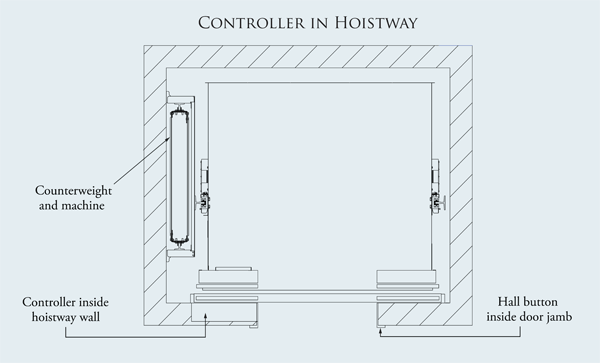
In true MRL models, compact controllers fit inside the hoistway, a key advantage over other elevators.
Drawing courtesy of Otis Elevator Company
The true MRL gearless traction model has been made possible by two main factors: the compact controller innovation and the inspection/test panel. In these true MRL models, compact controllers fit inside the wall of the top elevator landing, and most necessary test and maintenance features can be concealed behind a panel in the elevator entrance to give building personnel, elevator mechanics, and city or state inspectors access to the critical items they need. This inspection and test panel typically includes a mainline disconnect accessible to building personnel who may need to cut power to the elevator. There is also a separate lockable panel which houses the service port for elevator mechanics and access to the safety circuits in case of emergency or troubleshooting. In most jurisdictions, safety tests can also be performed from this panel.
The true MRL gearless traction model also features flexible coated steel belts, which have a significantly smaller bending radius than conventional wire rope, allow a smaller sheave, some 4 inches in diameter vs. a conventional geared sheave of 30 inches in diameter. This enables a more compact machine that is 70 percent smaller and up to 50 percent more efficient than conventional geared machines. Pits can be shallower and overhead lower, creating the smallest hoistways to date.
Some elevators of this type feature minimal vibration and in-car noise, which creates a smooth ride and quiet building environment. Cost savings are also realized. Based on estimates of general contractors in various parts of the U.S., a machine room for a traction elevator costs approximately $35,000 on average, and a control room, $5,000.
The Greenest Options
True MRL elevators are designed to minimize carbon footprint by optimizing the size, materials, and weight of components. Some models incorporate further energy-saving technologies. Because they are not always standard MRL features, early in the specification process architects should note whether the following five energy-saving elements are included in the model they have selected.
Gearless Machine
Permanent magnets boost the power of the motor, which enables a reduction in motor size. Some gearless machines are 70 percent smaller than machines used in conventional traction systems, and are compact enough to tuck away at the top of the hoistway. The system's efficient use of energy lowers elevator operating costs. With a permanent-magnet synchronous motor and digital VF closed-loop drive that combine to form an efficient system, the gearless machine can reduce power consumption by as much as 50 percent compared to conventional geared machines.
Coated Steel Belts
In the most environmentally sound elevators, flat polyurethane-coated steel belts replace the heavy woven steel cables that have been the industry standard since the 1800s. The belts make the smaller sheave possible. They are only 0.1 inch thick, yet they are as strong as woven steel cables and far more durable, flexible, and space-saving. There are several advantages to using these belts. Lying beneath the polyurethane coating of the belt are 588 high-tensile strength steel wires with zinc-plating to minimize corrosion. The polyurethane coating avoids metal-to-metal contact (of rope to sheave), reducing noise and vibration. It helps provide a smoother ride and higher level of passenger comfort not found in steel rope applications. In addition, coated steel belts have been found to have a life two to three times longer than conventional steel ropes.
Lastly, because of its design, the coated-steel belt eliminates the lubrication requirement of conventional ropes and its associated smells and messes as well as the need for storage, cleanup, and disposal of hazardous waste. Some manufacturers offer maintenance systems that electronically monitor the status of the belts' steel cords, and automatically detect and report belt faults to maintenance personnel.
Compared to hydraulic systems, the gearless MRL reduces car noise by 30 percent and vertical and horizontal vibration by as much as 75 percent. Compared to geared systems, this option reduces in-car noise and vibration by 25 percent. Coated steel belts help to improve ride quality. In terms of the machine, the sealed bearings reduce noise and vibration. Rubber pads are located at the bearing point at each end of the integrated machine and bedplate, and the sound-isolated structure keeps vibration to a minimum.
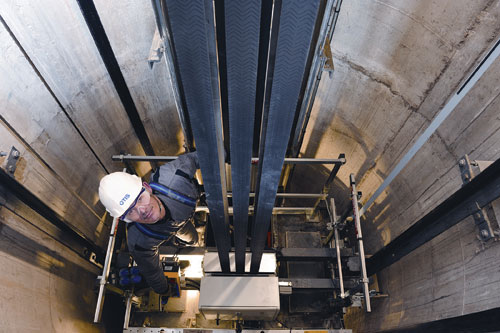
Photo courtesy of Otis Elevator Company
Coated steel belts are only 0.1 inch thick, yet they are as strong as woven steel cables and far more durable, flexible, and space-saving
Regenerative Drive Technology
All traction geared or gearless elevators will generate electricity. In simple terms this means that in certain modes of operation, the elevator motor will behave as a generator and generate electricity instead of consuming electricity. Specifically there are two primary modes of operation where the elevator motor will generate electricity:
- When a heavily loaded car travels in the down direction, it outweighs the counterweight and works with gravity. This motion generates electrical power.
- When a lightly loaded car travels in the up direction, the counterweight outweighs the car and works with gravity. This motion generates electrical power.
In non-regenerative systems, the electricity generated during these modes of operation is dissipated as heat into the machine room. This energy is wasted and in many cases the customer also has to add air conditioning to the machine room which is an additional expense.
In regenerative systems, the electricity generated during these modes of operation is converted by the regenerative drive to useful energy that can be used to power other loads within the building such as lights, air conditioning, office equipment etc.
Some regenerative drives also offer the additional advantage of creating clean electricity, which eliminates concerns that the elevator's regenerative energy will have a negative effect on other electrical equipment in the building.
In addition to energy savings and clean power, the regenerative controller also offers more space and flexibility. It is 50 percent smaller than the conventional geared controller, and uses up to half the space of a traditional non-regenerative traction controller. It is also quieter and produces less heat.
LED Lighting
LED lighting is another green feature with numerous benefits. LED lights are highly efficient and last up to 10 times longer than conventional fluorescent lamps, thereby reducing energy consumption. As they don't burn out and need replacement as frequently, LED lights also require less building maintenance. They also stay cooler than fluorescent lights, which means they use less energy to keep the cab cool.
Sleep Mode
Some elevator systems incorporate a “sleep mode” where car lights and fans are shut down when the system is not in use, eliminating the need to generate unnecessary power. When a passenger pushes a call button, the elevator instantly springs back to life. Sleep mode further enhances LED lighting. Used in conjunction with such an auto-shutoff mode, LED lighting becomes up to 80 percent more energy efficient than conventional lighting.
Both true MRL holeless hydraulic and gearless traction models can be equipped with LED lighting and sleep mode, features estimated to reduce annual energy consumption per kilowatt hour by nearly half. Architects should note whether these energy-saving features are standard on the model they are specifying.
Energy Efficiency: Why It’s Important
Industry engineers have concluded that, over a 20-year elevator life span, energy consumption has the greatest impact on the environment. In fact, two-thirds of the burden is from the energy it takes to power the elevator system over that 20-year period. Findings are for a traditional traction system.
Green features previously discussed — permanent magnet machines, coated-steel belts, regenerative drives, LED lighting, and sleep mode — offer real opportunities to reduce these operating costs and deliver environmentally sound performance. As indicated in the accompanying chart, incorporating these green options into an elevator design can have a dramatic impact on a building's energy bill. The total energy consumption for a gearless MRL is significantly lower than the hydraulic, geared, and gearless systems. The green, gearless MRL uses less than 2,000 kWh/yr versus the hydraulic which uses over 5,000 kWh/yr. Even the next best option after the MRL, the gearless system, uses approximately 3,500 kWh/yr.
How MRLs Stack Up in Terms of Energy Consumption
Due to several elements in its design, a permanent magnet gearless system with regenerative drive is up to 75 percent more efficient than either conventional hydraulic or traction elevators. The smaller sheaves, gearless design, and coated steel belts result in a better option for building owners interested in saving energy.
In another measure of sustainability, standards published by the Association of German Engineers, Verein Deutscher Ingenirure (VDI), known as VDI 4707 standards, assess elevator energy performance based on factors such as load, speed, frequency of use, and travel height, during both travel and standby modes. An elevator's energy demand is rated using seven different classes from A to G, where A reflects the highest rating possible (the least energy used) and G the lowest rating (the most energy used). VDI measures energy efficiency based on usage category on a scale from 1 to 5, where 1 represents low-use systems and 5 represents high-use elevators. Measurements taken on gearless MRL installations with regenerative drive configurations earned the highest efficiency class rating.
 |
|
Chart courtesy of Otis Elevator Company |
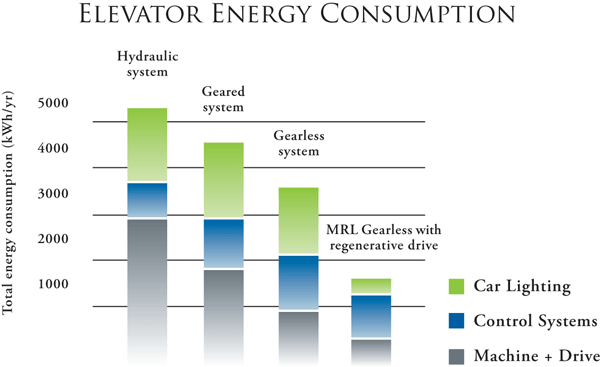 |
Chart courtesy of Otis Elevator Company |
The Manufacturer’s Sustainability Quotient
Architects interested in optimizing sustainability of their projects should examine each stage of a product's life cycle. In manufacturing, a key indicator is how well a company recycles industrial waste; some elevator manufacturers claim a recycling rate of 99 percent. Efficiencies during installation — which can include minimizing time required, materials used, packaging recycled — are another key way of gauging a manufacturer's commitment to sustainability. Technologies like remote monitoring allow companies to target maintenance activities so that drive time and gas consumption are reduced. Environmentally sound maintenance practices also extend to safe waste removal and non-toxic cleaners. Frequently, end-of-life practices allow re-use of more than 95 percent of product materials. Coated-steel belts in particular can be successfully recycled. Manufacturers that partner with suppliers tend to have specific recycling programs for those items.
Where MRLs Can Contribute to LEED Points
LEED, or Leadership in Energy and Environmental Design, is an internationally recognized green building certification system. Developed by the U.S. Green Building Council (USGBC) in March 2000, LEED provides architects, building owners, and operators with a framework for identifying and implementing practical and measurable green building design, construction, operations and maintenance solutions.
LEED does not certify specific products — only entire projects can earn LEED accreditation. While elevators and escalators cannot themselves earn LEED points, they can contribute to a project's achievement of LEED points in several areas.
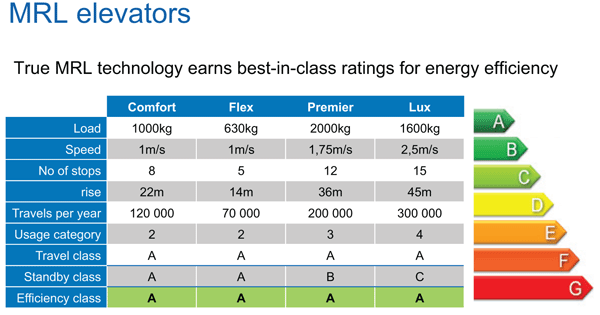 |
Chart courtesy of Otis Elevator Company |
Innovation and Design Credit 1 — Progressive Design
The purpose of this credit is to provide design teams and projects the opportunity to be awarded points for exceptional performance above the requirements set by the LEED-NC Green Building Rating System and/or innovative performance in Green Building categories not specifically addressed by the LEED-NC Green Building Rating System. Elevators incorporating the latest green MRL technology may be eligible for this credit.
Energy and Atmosphere Credit 1 — Regenerative Drives
According to the U.S. Department of Energy, buildings use 39 percent of the energy and 74 percent of the electricity produced each year in the United States. The Energy and Atmosphere category encourages a wide variety of energy-wise strategies: commissioning; energy use monitoring; efficient design and construction; efficient appliances, systems and lighting; the use of renewable and clean sources of energy, generated on-site or off-site; and other innovative measures. The intent of this credit is to achieve increasing levels of energy performance above the baseline in the prerequisite standard to reduce environmental and economic impacts associated with excessive energy use. Elevators and escalators with regenerative drive systems all increase energy efficiency and may be able to contribute to earning this credit.
 |
Chart courtesy of Otis Elevator Company |
Materials and Resources Credit 7 — Certified Wood in Cab
MR Credit 7 is a contributory credit. The intent is to encourage environmentally responsible forest management. If wood is selected as part of the elevator cab interior, installing Forest Stewardship Council- (FSC) certified wood could help to gain credit. A minimum of 50 percent (based on cost) of wood-based materials and products must be certified in accordance with the Forest Stewardship Council's principles and criteria.
Indoor Environmental Credit 4 — Paints, Sealants, Adhesives
The U.S. Environmental Protection Agency estimates that Americans spend about 90 percent of their day indoors, where the air quality can be significantly worse than outside. The Indoor Environmental Quality category promotes strategies that improve indoor air as well as those that provide access to natural daylight and views and improve acoustics. Vertical transportation systems may contribute to this credit by applying non-toxic paints, sealants, and adhesives in controlled factory environments.
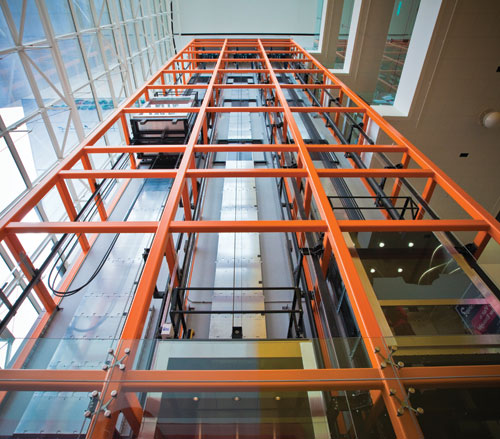 |
Elevators can contribute to LEED points.
Photo courtesy of Otis Elevator Company |
Smarter, Sustainable Vertical Transportation
The latest technology offers true machine-roomless elevators — products that give architects more design freedom, owners more revenue, and passengers greater comfort. With more compact motors and smaller footprints, next generation elevators generate greater energy savings. These savings can be further enhanced by several features including regenerative drives, coated steel belts, LED lighting and sleep mode functions. True MRLs also generate significant construction savings because they eliminate the need to build bulky machine rooms and control rooms. As architects and owners press for ever greener structures, vertical transportation has an important contribution to make.
 |
Otis Elevator Company is the world’s leading manufacturer, installer and maintainer of elevators, escalators and moving walkways—a constant, reliable name for more than 150 years. www.otis.com |







